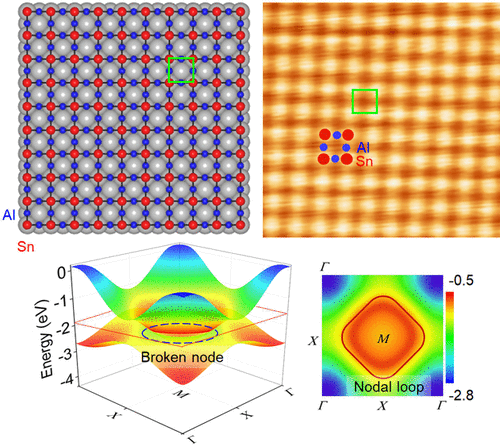当前位置:
X-MOL 学术
›
Nano Lett.
›
论文详情
Our official English website, www.x-mol.net, welcomes your
feedback! (Note: you will need to create a separate account there.)
Experimental Realization of Two-Dimensional Buckled Lieb Lattice
Nano Letters ( IF 9.6 ) Pub Date : 2020-03-17 , DOI: 10.1021/acs.nanolett.9b05316 Haifeng Feng 1, 2 , Chen Liu 3 , Si Zhou 1, 4 , Nan Gao 4 , Qian Gao 5 , Jincheng Zhuang 2 , Xun Xu 1, 2 , Zhenpeng Hu 5 , Jiaou Wang 3 , Lan Chen 6, 7 , Jijun Zhao 4 , Shi Xue Dou 1, 2 , Yi Du 1, 2
Nano Letters ( IF 9.6 ) Pub Date : 2020-03-17 , DOI: 10.1021/acs.nanolett.9b05316 Haifeng Feng 1, 2 , Chen Liu 3 , Si Zhou 1, 4 , Nan Gao 4 , Qian Gao 5 , Jincheng Zhuang 2 , Xun Xu 1, 2 , Zhenpeng Hu 5 , Jiaou Wang 3 , Lan Chen 6, 7 , Jijun Zhao 4 , Shi Xue Dou 1, 2 , Yi Du 1, 2
Affiliation

|
Two-dimensional (2D) materials with a Lieb lattice host exotic electronic band structures. Such a system does not exist in nature, and it is also difficult to obtain in the laboratory due to its structural instability. Here, we experimentally realized a 2D system composed of a tin overlayer on an aluminum substrate by molecular beam epitaxy. The specific arrangement of Sn atoms on the Al(100) surface, which benefits from favorable interface interactions, forms a stabilized buckled Lieb lattice. Theoretical calculations indicate a partially broken nodal line loop and a topologically nontrivial insulating state with a spin–orbital coupling effect in the band structure of this Lieb lattice. The electronic structure of this system is experimentally characterized by angle-resolved photoemission spectroscopy, in which the hybridized states between topmost Al atoms and Sn atoms are revealed. Our work provides an appealing method for constructing 2D quantum materials based on the Lieb lattice.
中文翻译:

二维屈曲Lieb晶格的实验实现
具有Lieb晶格的二维(2D)材料具有奇异的电子能带结构。这样的系统在自然界中是不存在的,并且由于其结构的不稳定性也很难在实验室中获得。在这里,我们通过分子束外延实验性地实现了由铝基板上的锡覆盖层组成的2D系统。受益于良好的界面相互作用,Al(100)表面上Sn原子的特定排列形成了稳定的屈曲Lieb晶格。理论计算表明,在此李布点阵的能带结构中,节点线环路部分断裂,并且具有非平凡的绝缘状态,具有自旋-轨道耦合效应。该系统的电子结构通过角度分辨光发射光谱进行了实验表征,其中揭示了最上面的Al原子和Sn原子之间的杂化状态。我们的工作为基于Lieb晶格构造2D量子材料提供了一种有吸引力的方法。
更新日期:2020-04-24
中文翻译:

二维屈曲Lieb晶格的实验实现
具有Lieb晶格的二维(2D)材料具有奇异的电子能带结构。这样的系统在自然界中是不存在的,并且由于其结构的不稳定性也很难在实验室中获得。在这里,我们通过分子束外延实验性地实现了由铝基板上的锡覆盖层组成的2D系统。受益于良好的界面相互作用,Al(100)表面上Sn原子的特定排列形成了稳定的屈曲Lieb晶格。理论计算表明,在此李布点阵的能带结构中,节点线环路部分断裂,并且具有非平凡的绝缘状态,具有自旋-轨道耦合效应。该系统的电子结构通过角度分辨光发射光谱进行了实验表征,其中揭示了最上面的Al原子和Sn原子之间的杂化状态。我们的工作为基于Lieb晶格构造2D量子材料提供了一种有吸引力的方法。











































 京公网安备 11010802027423号
京公网安备 11010802027423号